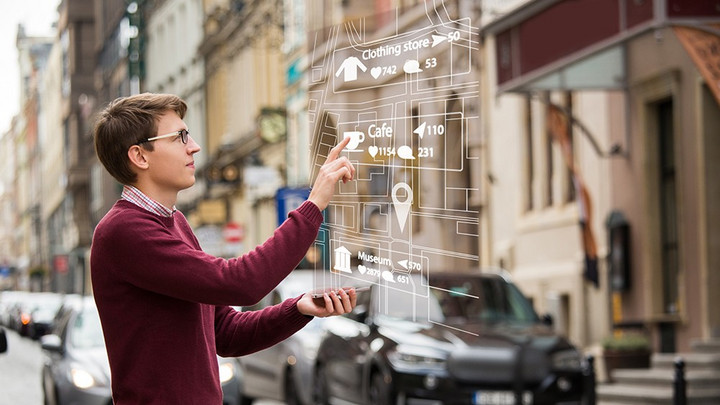Infrastructure for the Evolution of the City - Transcript
Spencer Hinzen from Ruckus, on the need for connectivity infrastructure in order for cities to evolve into the smart cities they want to become.

© Scharfsinn86 | istockphoto.com
Transcript
DOTMAGAZINE: What do you see as the main advantages for a city of offering smart city services?


SPENCER HINZEN: Through all centuries, you see that a city evolves by using innovative solutions. First, we had transportation based on horse and cart, and now we have full transportation services within the city. So it's all about the evolution of the city itself, and nowadays with all the innovation that is going on – IoT applications and smart-city applications – we see now the advantage for a city to use these innovations in order to create better and more efficient services than they already have.
DOT: What options do cities have for building citywide connectivity infrastructure?
HINZEN: Well, they have multiple options, of course. It depends on the focus and priorities that they have in the short, mid, and long-term.
These determine how they roll out such a smart city and its infrastructure. But it is certainly very important, the moment you start looking into such a project, to be sure that you not only have efficient services to be rolled out, but also have an infrastructure that is a future-proof one, where you can use that infrastructure for future purposes and for future services. The most obvious option for a city would be that they roll out an infrastructure that is ready to put all the services on top which they consider to be a priority for the mid and long-term.
DOT: Why is citywide Wi-Fi coverage important for the development of a smart city?
HINZEN: Well, we see the Wi-Fi infrastructure as the actual backhaul infrastructure for all RF technologies that are needed in order to roll out a smart city. Wi-Fi is a very important component of that infrastructure, and the result of all this will be that there is Wi-Fi present all over the city, and therefore the possibility to provide free Wi-Fi is actually a result of the rollout of that infrastructure. The goal, however, of the rollout of that infrastructure is to provide better services. But then again, it's a very good result at the end that you can offer free Wi-Fi by rolling out that infrastructure.
DOT: Looking at the different wireless protocols that can be used for smart city solutions, can you explain the relative merits and application possibilities for the most important ones?
HINZEN: Yes, I can. As I said, it's all about priorities. What kind of applications would you like to prioritize? Would it be transport solutions or would it be security solutions? Or do we have to have a focus on a government upgrade from a building perspective? Or is it healthcare, or is it entertainment and amusement? It all depends on the priorities that you have.
With these services, you will then be looking into specific applications that actually give you, as an end result, that better service that you are looking for. Having said that, these applications mostly use specific protocols from a sensor perspective. Just to give you an example, if I had a parking solution, I would probably have a sensor on the parking spot, and the moment that sensor's blocked, it actually says: “You can't park here”. Now, this sensor could use a protocol other than Wi-Fi, such as LoRa, or BLE, or ZigBee, and so on. All sensors that are used by the applications might have a different RF protocol, and the good thing about it is that we now have the ability to actually aggregate all these RF technologies towards one backhaul infrastructure, which can be centrally managed. But then again, every application has its specific protocol need to get the best out of the service that you are looking for.
DOT: Can you give us some examples of successful smart city projects that Ruckus has been involved with, and what impact they have had on the lives of their inhabitants?
HINZEN: Well, the most obvious ones, of course, are the big ones. For example, we were involved in the rollout of LinkNYC – which has been and still is a very big rollout project in Manhattan, New York – where they actually replaced the phone booths in Manhattan by what they call ‘connectivity kiosks’, where you still have the ability to place specifically 911 calls. But it is not only an advertising environment, but an info environment for the citizens, as well as for the tourists that visit Manhattan. Just to give you an example on that one, the impact is that the cable providers of apartments which are around those kiosks have been complaining to us because we provide better Wi-Fi on the streets than they do in the apartment buildings themselves. So, from a quality perspective, it is a tremendous success, and also from a return of investment perspective for the city itself, it also has been a huge success. Applications like bus schedules, where to go for entertainment, what the weather’s like – all these things are available in this infotainment environment.
Another example is the city of Eindhoven, where we also have a kiosk-based Wi-Fi rollout for which, for example, we use an application in Holland which they call 'Amber Alert'. Now, when a child or someone has gone missing, they send out an alert. In this specific case, the photograph of that missing person is then displayed on that kiosk for everyone to see, to keep an eye out for that person. So this is also an example of an application.
In the city of Monheim, in Germany, we rolled out an asset management solution for the free city bikes to track where the bikes are. We also provided free Wi-Fi services last year during the “Kieler Woche” (Kiel Week), where we serviced over 250,000 people on the quay of the Kiel Harbor in order to provide free Wi-Fi during the event.
These are just a few examples of cities that we rolled out, but the most important ones are the ones we don't see, where the city is actually rolling out, as we speak, a very large diversity of solutions that they prioritize, while using the Wi-Fi as a backhaul infrastructure.
Spencer has a track record of more than 25 years in the IT industry. Being part of Ruckus since 2012, he set up the BeNeLux region, and subsequently led the sales teams in Southern Europe. Since 2016, he has been responsible for business development in EMEA, leading the effort to introduce the visions & strategies on smart cities, retail, and IoT in the region.
Please note: The opinions expressed in Industry Insights published by dotmagazine are the author’s own and do not reflect the view of the publisher, eco – Association of the Internet Industry.



